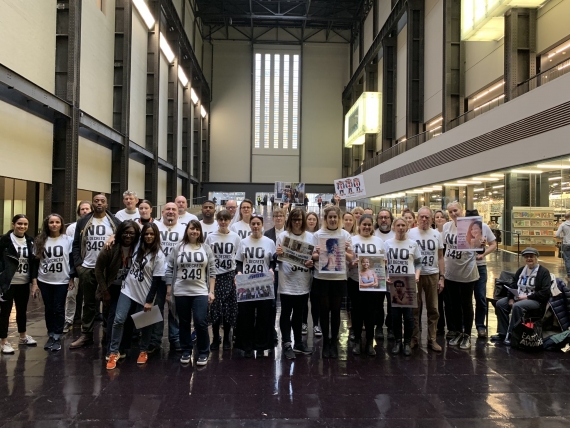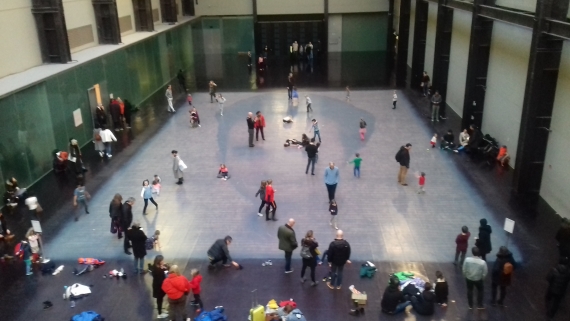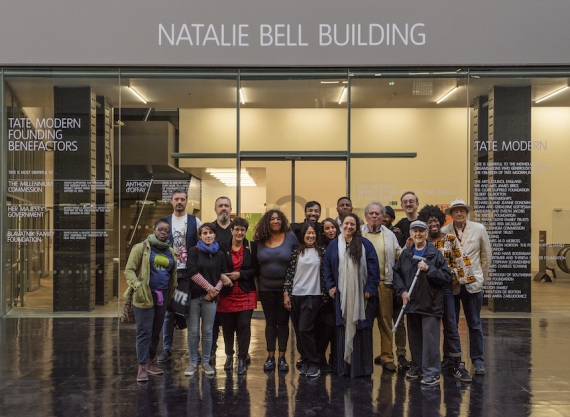Tania Bruguera and Tate Neighbours
Artists who Risk/Artists at Risk: Tania Bruguera and Tate Neighbours
There’s a fine line between ‘artists who risk’ and ‘artists at risk’. The Cuban artist, Tania Bruguera, crosses this line with apparent ease yet with grave implications, as seen in her recent arrest and detention in Havana along with other artists in protest against Decree 349, which planned to forbid artists to practice without a government license.
In 2018 Counterpoints Arts was invited by Tate Exchange to work with Tania Bruguera in the context of the Hyundai Tate Modern Commission. Counterpoints were ‘fans’ of Bruguera from her ongoing Immigrant Movement International (along with much of her previous work), but didn’t quite know what to expect – what might be the form of this collaboration? Bruguera’s performative approach is to ‘initiate’, rather than claim ‘sole authorship’; to ‘implement’ and transform the host institution into a ‘transitional institution’ - all interesting in theory but what might it mean in practice?
The central spine of Bruguera’s Turbine Hall commission has been her work with the Tate Neighbours group. Tate Neighbours is a diverse collective of approximately 21 people (and growing) living and working in SE1. Bruguera’s insistence on bringing the voices, perspectives, skills and life experiences of Tate Neighbours into the Tate Modern as equals has ensured that the Turbine Hall installation is driven by the community itself – definitely a ‘first’ for the Hyundai Commission and hopefully a trend for the future.
Tate Neighbours has opened a space for active citizenship and dialogue across difference in relation to migration and other social issues. As Bruguera puts it elsewhere about how she works with participants: "…participants are incorporated and become collaborators. One of my goals is to create a new community that in itself contains and enacts a different social and political structure…not about “being together” but “being together in order to…” (Tania Bruguera and Suzanne Lacy in Conversation, Tania Bruguera: Talking to Power/Hablándole al Poder, 2018)
The title of Tania’s Turbine Hall work challenges any passive framing. 10,148,451 indicates the sheer volume of migrant deaths en route, those displaced and disappeared globally (with numbers changing daily reflecting the sheer magnitude of the treacherous journeys – and drawn from data in IOM’s Missing Migrants). 10,148,451 directly hails the audience with a jarring juxtaposition: the construction of a ‘forced empathy’ room inducing manufactured tears from visitors; alongside a concealed portrait of a young Syrian man, Yousef, whose face is hidden underneath layers of heat sensitive paint applied to the Turbine Hall floor. Visitors to the Turbine Hall have since revealed Yousef’s ‘portrait’ over the last few months through constant wear and tear and bodily heat.
Yousef’s story is interlinked with local activist, Natalie Bell, whose name is emblazoned on the Boiler House (directly opposite the Blavatnik Building). Bell was nominated by the Tate Neighbours group in homage of her exceptional service as Head of Youth and Community at Coin Street Community Builders, a local SE1 initiative. Hence the relational backstory of Yousef who knocked on Bell’s door homeless, having arrived in London from Syria with no supports but who is now studying medicine.
Throughout the months prior to the public launch of 10,148,451 in October 2018, we observed Bruguera navigating (tenaciously) the various departments of Tate Modern in a quest for the Boiler House to be named in honour of Bell (who is herself a second generation migrant). This new ‘naming’ is literally etched into the DNA of Tate Modern – through its public hallways, maps, signage and elevator spaces – signaling a tribute to Bell and the civic values she espouses. Her work with vulnerable young people over many years stands in stark contrast to the traditional naming of public buildings after ‘wealthy’ patrons.
Tate Neighbours’ key aim and shared mission is the viability of Tate Modern as a truly ‘civic institution’. This mission has been facilitated by Bruguera and Tate Modern/Tate Exchange in the re-portioning of the commission budget to underwrite a two-year Tate Neighbours’ programme. Might this be the beginning of an arts-led ‘people’s assembly’ (a version of what transpired in Ireland and elsewhere); or a forum for active citizenship? Or at least a new patronage model for socially engaged arts practice?
Bruguera describes ‘the spectacle’ in Turbine Hall as merely the prerequisite for a deeper, durational project shaped by the Tate Neighbours. Describing her work as ‘pre-emptive’ rather than ‘reactive’ she also prefers the word ‘initiator’ to ‘provocateur’:
‘Provocateurs don’t take responsibility for what they provoke, they fly away quick and leave the people they invited to the work on their own. A political artist works with the consequences generated by their work, they understand that the work is done precisely there, they accompany those they have involved all the way, they create dialogue and process. My work is to set up the conditions for something to happen and be there to accompany the consequences’. (ibid)
It is perhaps too early to say if a ‘new community’ is born in the wake of this Turbine Hall Hyundai Commission. Or that meaningful structural change will emerge. Structural change is mostly slow, sometimes painful and often hard to pull off. But...
Part of Counterpoints Arts' collaborative role as Lead Associate at Tate Exchange has been to work with Bruguera and to attend the weekly conversations, which have taken place at Tate Exchange from June to October 2018 and beyond. Lively, informed, at times charged but always humane and generous, these Neighbourly gatherings have been a real inspiration and a joy to observe and participate in.
Most moving of late was the pre-Christmas protest organised by Tate Neighbours in the belly of the Turbine Hall in solidarity with Bruguera and other artists in Cuba, as they faced the harsh implications of Decree 349. Success for Bruguera is beautifully described (in marked contrast to some other artists) as that pivotal point when ‘people involved in the project cease to be participants or community and become friends…[success] is if the project was able to create a different and new community.’(ibid)
There is still a way to go with Tate Neighbours but all the signs are looking good.
More than ever we need cultural activists and brave if not persistent socially engaged arts practitioners like Bruguera to help initiate such projects, to enable groups like Tate Neighbours and the public at large to imagine itself as part of a democratic and diverse citizenry. Where difference is seen as an integral civic value and not an inherent, endemic threat. And where art institutions are genuine civic spaces for everyone and authentic sites for social transformation.
The Art of Social Change film can be viewed here.
ÁIne O’Brien,
Co-Director Counterpoints Arts
Categories: Featured Artist
Date Posted: 24 January 2019



